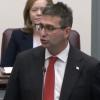Campgrounds are big business for Delaware parks
Americans invented national parks for the world. States followed with state parks for a population hungry to get outdoors and to see some of the most beautiful parts of our country.
In Delaware, not only are our state parks great places to visit and be outdoors, they are also big business. And that business is growing.
At a National Campout Day at Trap Pond State Park last weekend, Delaware Division of Parks Director Ray Bivens said the overall number of nights that campers have booked in Delaware parks is up 35 percent over the past two years.
“We’ve listened to what people want in their camping areas; we’ve spent money to meet those requests, and the result is more people coming and staying longer,” said Bivens. “In April alone this year, we had 2,500 more bookings statewide than we had last year. We’re completely booked in all of our campgrounds from Memorial Day to Labor Day, and we see more campers coming in the shoulder months: April, May and November.”
What makes the 35 percent increase even stronger, said Bivens, is the fact that the campground at Cape Henlopen State Park, one of the most popular in Delaware, was closed for construction up until Memorial Day weekend in both 2015 and 2016.
With 16 state parks, the Division of Parks has an annual expense budget this year of $21 million. Of that $21 million, 65 percent is funded by revenues generated by the parks through camping fees, permits and entry fees. The remainder is picked up through the state’s general fund. That means that in this fiscal year, Delaware’s parks generated more than $13 million. “We’re primarily self-funded,” said Bivens, “especially compared to our neighbors. Maryland park revenues meet about 20 percent of their expenses; in New Jersey it’s 25 percent and in Pennsylvania it’s 30 percent.
“We have to,” said Bivens. “That’s the way our model is set up. We’re more entrepreneurial than in other states. We work closely with our small business partners.”
Bivens mentioned the lease purchased by Big Chill restaurant for its new venture on the south side of Indian River Inlet, and Quest Kayak now handling boat rentals at the Cape Henlopen State Park fishing pier as examples of partnerships. In 2016, businesses operating in Delaware’s parks generated more than $5 million in receipts. He said small businesses are coming to the parks with ideas which can further help the parks meet their expenses.
Cabin rentals big
Bivens said the increase in nightly bookings includes rentals of cabins, cottages and yurts in the parks. “The new cabins in Cape Henlopen State Park are the most popular accommodations in the whole state park system.” He said improvements to camping sites on the north side of Indian River Inlet - to make them full-utility sites - has added to the increase in bookings. “Indian River Inlet - including both sides - is now the largest campground we have. I think all told, we have between 800 and 900 campsites statewide.”
Making the campsites at Lum’s Pond in New Castle County full hookup sites has greatly increased bookings there. “People buy these RVs with all kinds of features, and they want full services so they can enjoy them,” Bivens said.
Delaware’s campgrounds get strong use not only from visitors, but from people who live in the local area too. “Forty to 50 percent of people camping at Trap Pond State Park live within four to five miles of the park,” said Bivens. “Farmers like the fact that they can take their families camping but still get away during the day to get work done on the farms.”
Bivens said there was grumbling among some campers at Cape Henlopen State Park when they came back to a revamped campground this year.
“They missed the more primitive style that defined the campground previously. We were reacting to data we collected from surveys. We were told they wanted more bathrooms. We doubled those accommodations. They wanted electricity. We added that. They wanted water and sewer - we added water - and they wanted larger sites for RVs which we also provided. They also wanted Wi-Fi signals but we couldn’t afford that,” said Bivens.
“People say we took out a lot of trees, but it really only amounted to a handful when we shrunk the width of some of the roads. But we also created a walk-in tent site area so we would have something for everyone.”
Bivens said people also asked for a camp store at Cape Henlopen for basic items like ice and a cup of coffee. “So we turned one of the old bathhouses into a store.
“They also asked for a playground, and we added that.”
All of that adds a double meaning to the term ‘accommodations.’






















































